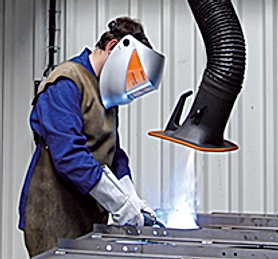Safety & Health

Safety & Health
Welding Fumes
Welding processes that develop fumes should be equipped with effective exhaust hoods, connected to an effective exhaust system. An interlocking device should be installed to link the machine’s power supply and the exhaust system to prevent the operation of machines without the exhaust system operating.
Respiratory Protection – Respiratory
The Problem:
Welding fume litigation requires testimony to complex scientific issues concurrent with findings from specific medical maladies in neurology, toxicology and epidemiology. Physical science, engineering assessments and medical diagnosis are expected to converge and form a legal consensus which does not always happen. The testimony of experts must be complementary from engineers and the medical community for each case, date, process and workplace. Accurate data about resultant personnel disorders and biological dysfunctions are often not easily exchanged between engineers and medical practitioners. Reports of findings can be biased, misleading and violate common sense.

Welding Fumes in Breathing Zone

Welding Fume Mitigation

Welding Workplace Extractor
My Assessment:
Process fume constituents vary with metal compositions, flux and temperature. Workplace arrangement, ventilation and PPE are case specific. Components of smoke and fumes are oxides of iron, manganese, chromium, nickel, aluminum, cadmium and zinc as well as carbon monoxide, nitrogen oxide, and ozone. Fumes often have a metallic odor and the composition varies with height from floor level. Dangers to personnel from processes are mostly hazards that affect the eyes, nose, throat, lungs, blood and skin.
The Consequences:
The results of breathing fumes and gases have acute or long-term effects. The employer’s workplace compliance with ever-changing safety regulations for welding, soldering, brazing and joining process effects on adjacent workers are case specific. Experts must collaborate on the medical findings of each case to assess concentrated effects of fume constituents, workplaces and required techniques that mitigate hazards. Employers have a statutory obligation to provide a safe workplace for all workers.
The Lessons Learned:
Welding tasks require review and application of the warnings and danger labels. Workplace ventilation and respiratory protection are OSHA requirements. Fumes and gases can be hazardous to anyone’s health. Keep your head out of the smoke and don’t breathe the fumes.

